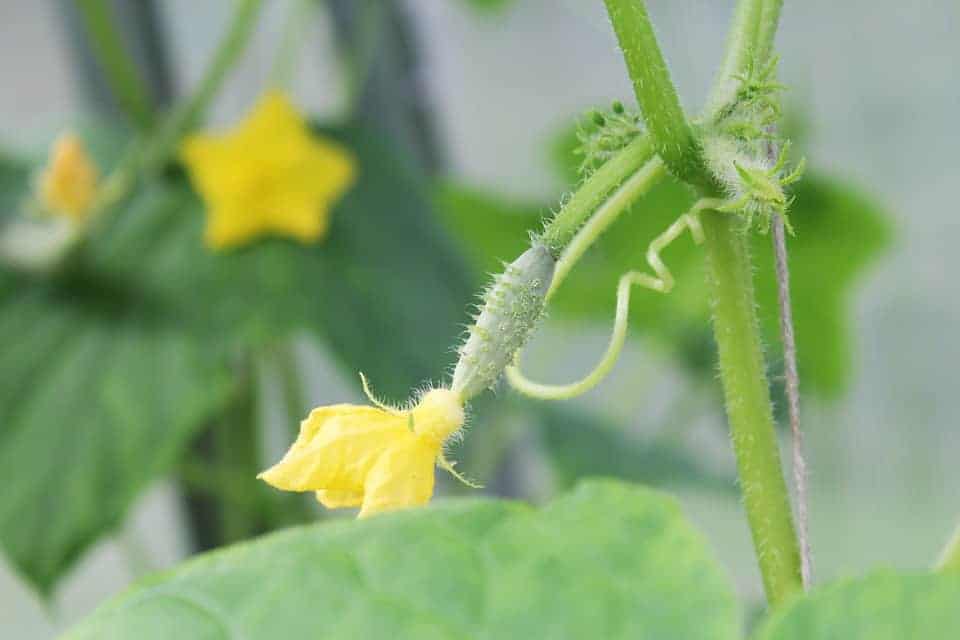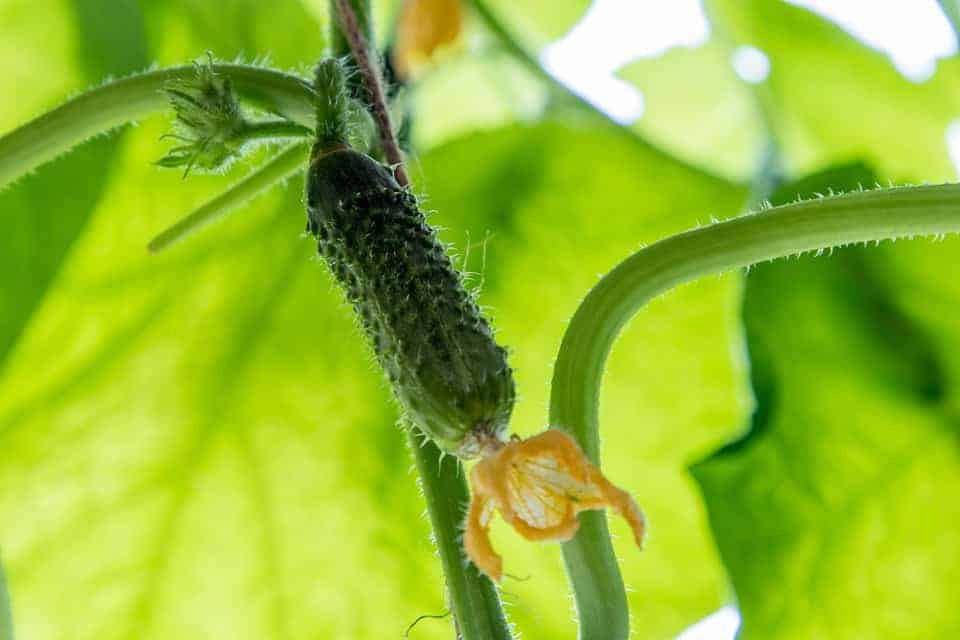Growing cucumbers indoors can be rewarding. It’s one of the fastest-growing fruit-bearing vegetables you can grow along with zucchinis. You can get fruit ready to pick in less than 50 days from sprouting in some cases. And the best part is, you avoid all the pests like squash bugs and cucumber beetles ruining your harvest if you grow indoors.
Growing cucumbers indoors is not difficult but has some unique challenges compared to other fruiting vegetables like tomatoes. Indoor cucumbers will need to be pollinated by hand unless you grow a parthenocarpic cucumber variety which can produce fruit without any pollination. You will need adequate light, at least 14 hours up to 20 hours, with fluorescent or ideally full-spectrum LED grow lights. Containers should be at least 1 foot (30 cm) deep and wide; larger is better if you have the space. If you want to save space, bush cucumber varieties are recommended, but you can still grow regular vining cucumbers with support.
On this page:
Manually Pollinating Indoor Cucumbers vs. Parthenocarpic Cucumbers
If you grow most cucumber varieties indoors, you will have to manually pollinate your flowers, otherwise you will not get any fruit. Unlike tomatoes and peppers, cucumbers have separate male and female flowers, so outside they will have to be either pollinated by insects moving from cucumber flower to cucumber flower, or pollinated by hand. Indoors, you will have to do it yourself.
How to Pollinate Cucumbers by Hand

Don’t feel daunted by it, because it’s very easy to pollinate cucumbers by hand. First you need to have female and male flowers open at the same time, and they usually open early in the day. Indoors, this will be when the grow lights turn on. Male flowers and female flowers look similar, but behind female flowers is a little baby cucumber and behind male flowers is just a stalk.
There are a few ways you can do this. Since cucumber pollen is not viable for very long, and it’s not like any bees will be visiting your plant, you can cut off the male flower, pull off the petals, and carefully dab the center of the male flower where the pollen-producing anthers are on the center of the female flower a few times. Some people will take a brush or small cotton swab and cover it in pollen from several male flowers, then gently dab the center of the female flowers.
You will know it was a successful pollination because within a few days you’ll see the baby cucumber starting to grow. Now you know how to pollinate a cucumber, and this principle works exactly the same for other cucurbits such as watermelons, canteloupes, summer squash, winter squash, and gourds.
If you grow cucumbers indoors, I’d recommend growing at least two plants so you can have a better chance of male flowers and female flowers opening at the same time. Some cucumber varieties are also self-incompatible, meaning they have to be pollinated by another plant.
Parthenocarpic Cucumbers

If you don’t want to manually pollinate your cucumbers, there is another option: parthenocarpic cucumbers. These are hybrid varieties of cucumbers that are bred to produce fruit without pollination, and in fact people report that they don’t taste as good if pollinated.
Many of these varieties also produce mostly female flowers, so they naturally have very high yields compared to non-pathenocarpic varieties. These are often grown in greenhouses or short-season cold climates with few natural pollinators. I’ve always enjoyed my traditional English cucumbers, but I’ve started making parthenocarpic cucumbers (and zucchini squash) staples in my garden. Socrates, Tyria, and Picolino are popular varieties you can easily find seeds for.
Growing Vine Cucumbers vs. Bush Cucumbers Indoors
Another thing you have to take into account is what growth habit of cucumber you want. Vine cucumbers grow like a sprawling vine whereas a bush cucumber will stay relatively short and bushy.
Both will need some kind of support, but since you’re growing indoors, you can get away with letting your cucumber plant flop about on the floor since there’s no risk of insects eating them. If you really are short on space, I’d recommend a bush cucumber which will be more compact, but you can always cut back and prune a vining cucumber if it starts getting wild on you.
If you’re interested in learning more about supporting cucumbers, I go into more detail about growing vine and bush cucumbers vertically and how to train them.
Light Requirements of Cucumbers
Cucumbers, like other cucurbits such squash and watermelon, grow best in full sun, a minimum of at least 6-8 hours of direct sunlight a day.
Since your grow light won’t be as powerful as the sun (if it is, I want to know!), you should be keeping your grow lights on for at least 14 hours a day, up to 18 or 20 hours. Avoid a 24-hour light cycle, as constant light negatively affects your cucumber plants’ health. Always keep your grow lights at least 4 inches above the plant to avoid burning the leaves and after it grows the first few true leaves, check it every day because cucumbers can grow incredibly fast.
Grow Lights for Cucumbers
You have many options for grow lights depending on your budget and how many plants you want to grow. You can get away with good fluorescent lights, but to maximize growth without spending too much, I recommend getting an LED grow light. They used to be this kind of “blurple” color a few years ago that was hard on the eyes, but now you can get natural, white full-spectrum LEDs on the cheap.
I won’t get into many specific models for cucumbers, but popular brands include Mars Hydro, Hidden Harvest, and SANSI. I personally have a Mars Hydro 300W (actual power draw is ~135W), a couple SANSI 70W grow lights, and several SANSI 36W bulbs. I haven’t grown cucumbers under grow lights, but I’ve had success with peppers, tomatoes, and even a watermelon plant. The main issue is whether there is enough spread of light for such a large plant. If I were to use my SANSI lights, I’d set up more than one so the entire plant can get light.
Here’s a video where you can see someone successfully growing a cucumber plant under grow lights hydroponically:
I love my tomatoes but I have to try this sometime.
Growing Cucumbers in Containers
I’ve already talked about growing cucumbers in containers but I’ll give you the cliff notes here. Cucumbers can get massive, so you should have a large container. I’d start with something at least a foot (30 cm) deep and a foot wide. If you have the space for a larger container, it’s even better. Outdoors, I recommend 5-gallon (19 L) buckets if you have the space, but indoors a 5-gallon bucket might be overkill.
More Tips for Growing Cucumbers Indoors
When Can I Harvest Indoor Cucumbers?
Very soon after pollination, the baby cucumbers will begin to swell, and in less than two weeks you should have a full-sized cucumber. How big should a cucumber be before you pick it? That will depend on the variety.
You can harvest cucumbers at any stage, any time before it starts to change color and ripen. Don’t let your cucumbers ripen on the vine unless you want to save seeds; if the plant is focusing on ripening cucumbers, it will use less energy to develop new cucumbers.
When harvesting, it’s recommended to leave a little bit of the stem attached to the fruit, which will allow it to last a bit longer before spoiling.
How Do I Fertilize Indoor Cucumbers
Cucumbers are heavy feeders, so I recommend feedings with liquid fertilizer every 7 to 14 days, or you can apply a slow-release fertilizer after transplanting to their final containers according to the package instructions.
Jobe’s Tomato Spikes are my go-to slow-release fertilizer for fruiting vegetables but you can go with anything with a balanced NPK or one that is lower on nitrogen (N). High nitrogen fertilizers are great for green leafy growth but not for flowering and fruiting, so if you use too much nitrogen you could end up having a flourishing cucumber vine with few actual cucumbers.
